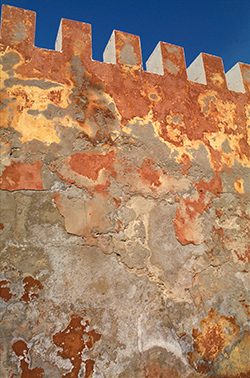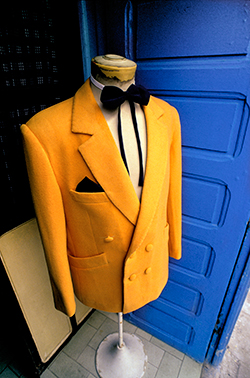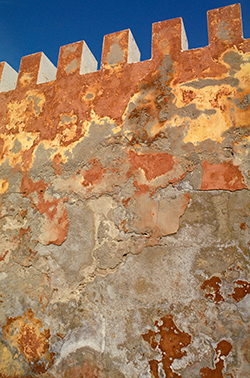|

travels
in amira
In
Xanadu did Kubla Khan
A Stately pleasure dome decree
With
such lines did Samuel Taylor Coleridge cunningly trip a switch for his
reading public, introducing them to a mythical land of heightened sensitivity
and super-stimuli: a world of exotic sounds, colours and perfumes; a world
they had never been to, but were in some strange way already familiar
with; a world located somewhere.... in the East.
There
is more than a touch of the Orient about Amira, the mythological land
evoked in the exhibition Travels in Amira by artist Karl Grimes.
Like Xanadu, Amira is a fantasy. It is a confection of all that is delightful,
a place where our visual senses are lightly pleasured and our dormant
prejudices gently reaffirmed.
By
and large, the photographs depict Middle-eastern styled interiors, doorways,
shopfronts and architectural features. Colours are bright and assertive,
favouring rich 'ethnic' hues. The mundane items depicted - shop dummies,
sift drink bottles, advertising plates - take on the air of exotica that
foreign-ness confers. But here also are familiar Western scenes and icons
- the Empire State Building, the Manhattan skyline by night etched in
neon, plaster busts of Elvis, blonde B-movie starlets. East in West. Or
could it be the other way around? Whichever, all appear to coexist in
Amira.
In
his book Orientalism Edward Said posits the notion that Western
depictions of the East tell us more about our own Western culture than
they can reveal about the 'Orient'. Grimes' exhibition blithely mixing
West and East and vice versa, seems wary of this idea: our perceptions
of one derive from our experience of the other.
Rugs,
wall-hangings, murals and framed portraits occur frequently throughout
these works. They function in a manner of theatrical backdrops, setting
up a series of layered tableaux within the one picture frame, striking
a definitive note of artificiality and illusion. The Oasis of Nefta
depicts a mural painting of desert and palm trees, cruelly punctured by
a roughly gouged wall vent, and teasingly heralded by a real projecting
sprig of greenery. The theatricality is echoed in the installation-like
redecoration that the gallery has undergone. Red walls with golden Arabic
script, white muslin drapery and a tri-faceted text work joyfully ape
a 'middle-easternism'.
The
images are almost filled to bursting point with frames themselves. Window
sashes, picture surrounds, wall ends and rug borders all jostle for position
within the photo frame. In casting the frame as a subject in itself, Grimes
draws attention to its restrictive delineation of the boundaries of a
given perspective. The triptych format employed by each of these pieces
re-stresses the role of the frame in separating individual perspectives,
and in suggesting possible relationships between diverse images. By also
dividing the exhibition space into two areas, Grimes establishes another
level on which this dynamic of separation and relation can be played out.
The
subjects of these photographs are frequently themselves objects of depiction.
Because of close cropping, they tend to fall only partially within the
photo frame, their edges extending beyond the border of the image. What
we see are images of parts of images. Lots of them. The Empire and
the City of Lights shows us not the Empire State Building, but a scaled
architectural model of the same. The Ceremonial Robes of the 12th Court
appear, humorously enough, in a shop window on a tailor's dummy, but
are also present as robes which have been rather crudely painted onto
the shop's window. Photography, the medium of representation par excellence,
seems here to succeed only in capturing the image of existing representations.
Amira
is peopled by a motley collection of personalities, who are present in
so far as their portraits are photographed. The only time we are present
with a live subject, a nude subject, the photographer has called upon
a mirror reflection to capture the image. The mirror is at an angle and
the subject's face and identity are cropped from the resulting reflection.
Despite the guileless nudity, the photographer must rely on imperfect
representational devices to give an account of himself.
The
apparent abundance within these images belies the fact that we are constantly
made aware of what has fallen outside the picture. The photograph's limited
ability to tell the whole story is brought into relief. Urged to suspect
the singular perspective and the integrity of the photo image, we can
draw no comfort from the various captions Grimes uses. The convoluted
titles are as richly evocative and as slippery on meaning as the imagery
they describe.
Madam
Piver is Remembered in the Cafe of the Fondouk, The Court Tailor Displays
the Royal Garments at Sunrise, Queen Ivana Warns of False Gods, all
suggest a sense of history, ritual and fable beyond the superficial acquaintance
with Amiran culture we are offered here. The golden Arabic signs which
decorate the walls look convincing enough, but they remain inscrutable
to the western eye.
Grimes
sets up all these potential meanings in the way of a domino chain, then
gleefully tips them over. It can be exhilarating to watch the chain reaction
as one debunked meaning tips over another and so on. The final triptych
in the sequence of images is entitled The Royal Palmery of Amira.
Of course, the palmery exists only as shadows of palm trees thrown up
against a pink sun-baked wall. Ultimately, this exhibition is an exuberant
celebration of the potency and mastery of such shadows.
Paddy
Johnson
Reproduced by permission from Circa Magazine, Autumn, No 65, 1993.
REVIEWS
Moroney, Mic . 'Fabled zone where kitsch is reality'.
Irish Times, June 18. 1993
Johnson, Paddy. 'Karl
Grimes-Travels in Amira'. Circa, Autumn, No 65, 1993.

|


